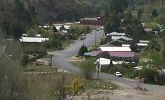| "The type of deposit to
which I am referring is a lead, zinc, copper sulphide
deposit with subsiding amounts of silver and gold.
Geologists have only recently recognised the true nature
of such deposits and worked out how they must have
formed as the result of slow movement of continental
plates across the earth's surface (Australia, for
example, is drifting north at the rate of about a mile
every thousand years). Where one continental plate,
collides with another, one of them gets pushed down and
the other rides over the edge of it; and volcanoes of
acid lavas (acid volcanics) pour out at the earth's
surface when the deeply buried down thrust plate melts.
Below the surface flows of acid volcanics there is
often a great mass of molten granite, and the lead,
zinc, copper, sulphur, gold and silver separate out from
the main molten granite mass (boil out from the top of
it) and sometimes make their way to the earth's surface,
through cracks and fissures (faults); and if such
material boils out below sea level, and solidifies, and
gets covered with sea floor sediments, it becomes what
we term a syngenetic stratiform sulphide deposit. The
first such syngenetic, stratiform sulphide deposit to be
recognised as such in Australia was in fact that at the
great Rosebery lead, zinc, copper mine in Tasmania, but
the first one recognised on the Australian mainland is
the one at Captain's Flat.
The valuable elements (the lead, zinc, copper,
sulphur, silver and gold) came welling up from deep
within the earth (being some of the relatively easily
volatilised material in the molten granite) in Silurian
times (about 420 million years ago). It boiled off the
top of the granite mass at the last gasp of the volcanic
activity that had earlier pushed up the acid volcanics
so that finally the lead, zinc. copper, gold and silver
were either deposited in the acid volcanics or boiled
out into the air and were dissipated, or boiled out
below sea level and precipitated in the cold sea water
to form the Captain's Flat type deposit, later to be
covered over with sediments washed down onto the sea
floor.
The roots of the volcanic plugs from this type of
volcanic action are also targets for todays mineral
exploration, because they often contain payable gold,
and the numerous cracks and fissures for miles around
the plugs are often filled with veins of white quartz
containing occasional silver and gold. The lead, zinc,
and copper metals came welling up through the cracks in
the form of chloride volatiles (lead chloride for
example) in the last gasp of the volcanic activity,
because normal silicate minerals cannot contain them in
their mineral lattice. The metals are then precipitated
on the sea floor as sulphides (see the diagram). The
lead and zinc (and a little copper) at Captain's Flat
were finally deposited on the floor of the ancient
Silurian sea, and covered over with silt, to be later
rediscovered as the Captain's Flat mine long after the
sea had gone and the land had risen up as a mountain
range. Some of the gold and silver went in with the lead
and zinc and copper sulphides, but some stayed lower
down in the quartz reefs and in the acid volcanic
material in the root of the volcanic plug itself." |
This information is taken in
part from an article written by John Erskine (Mining
Engineer) and published on 4 October 1980 in The
Captain's Flat Mining Record |

